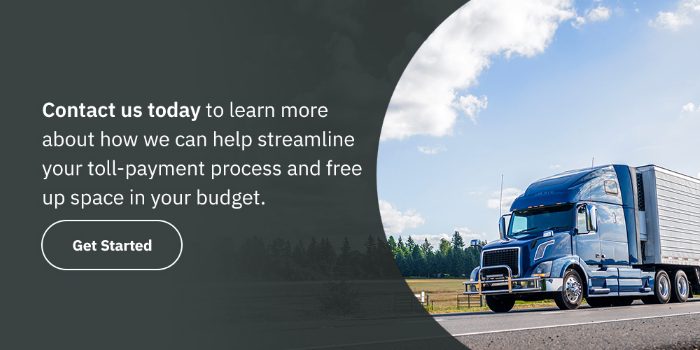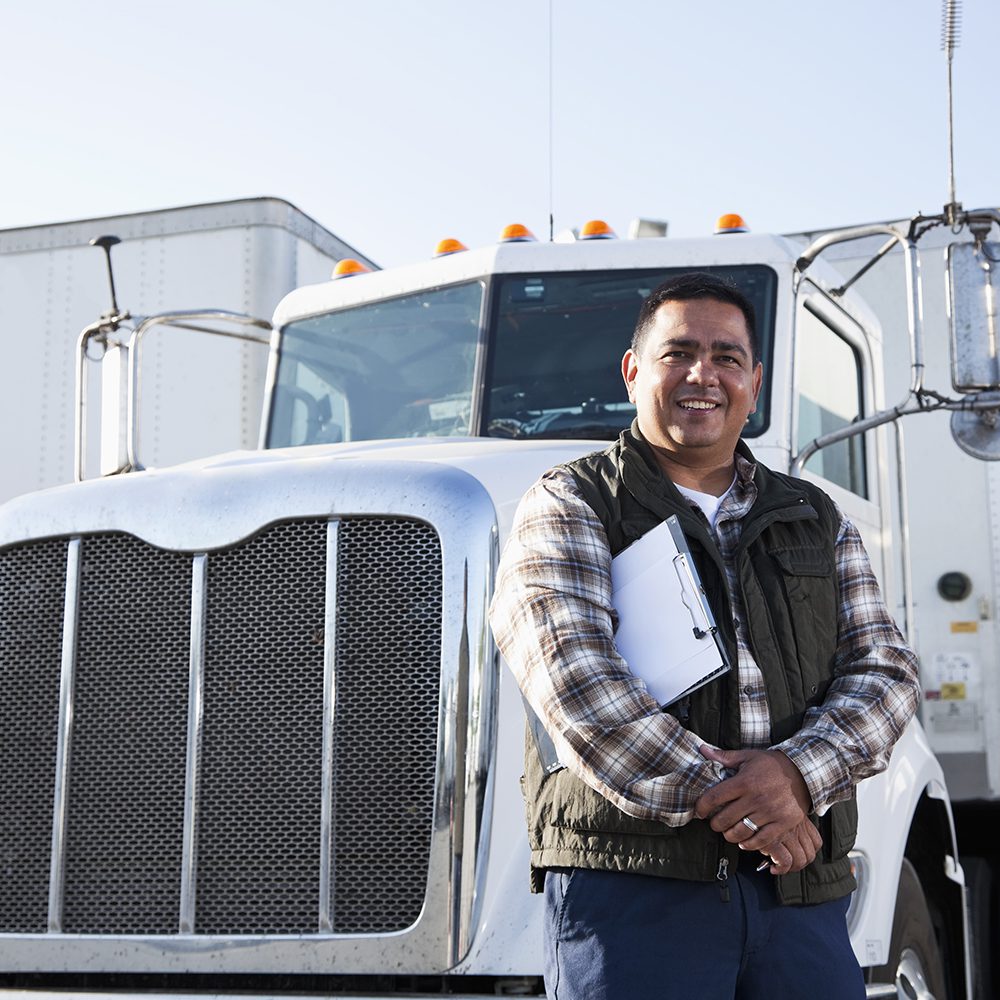
Fleet Budgeting and Forecasting
You have many responsibilities as a fleet manager. One of the most important responsibilities is ensuring your fleet is profitable and keeping costs to a minimum. But when dealing with vehicles like the ones in your fleet, you already know that expenses will arise. That’s why you need to budget and forecast your fleet’s monetary needs.
Many organizations measure their fleet’s success by how low its costs are compared to how much money it generates for the business. You must ensure your fleet operates as efficiently as possible. To do this, you must understand fleet budgeting and fleet forecasting. When you know how to build a fleet budget and understand fleet forecasting methods, you’ll be in a better position to make the right decisions regarding fleet costs.
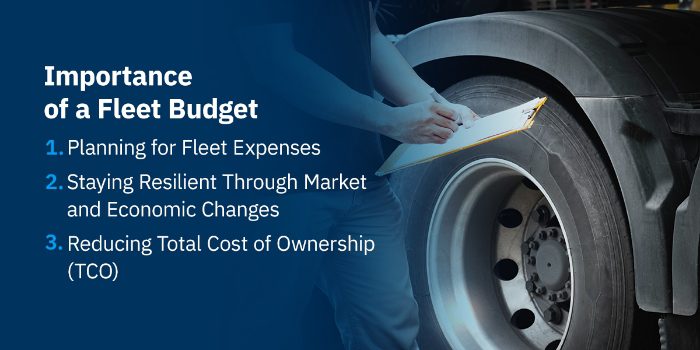
Importance of a Fleet Budget
The budget is the measurement of a well-run fleet. It’s one of the most important aspects of fleet management, guiding monetary decisions and revealing the profitability of your fleet. By staying within budget, you can ensure your fleet is a fruitful branch of your business.
A budget is also the key to fleet cost management and understanding how and where you can make changes. By lowering or raising your fleet’s budget, you can open up more capital space for other areas of your business or achieve the spending needed for fleet upgrades and maintenance. Your fleet is one of your company’s biggest assets, and you need a set budget to ensure all of the vehicles continue running for the maximum usable life span.
Having a budget for your fleet opens up the doors of opportunities for several positive benefits. Here are three main reasons why having a fleet budget is so important.
1. Planning for Fleet Expenses
Every fleet has expenses. If you’re expecting growth in the coming year, then you’ll need more room in your budget to accommodate that growth. A growing fleet will come with more expenses to consider, so you must craft a budget that can handle those increased expenses.
Whether you’re expecting to see your fleet grow, downsize or stay relatively the same in the coming year, you must understand your expenses. Plan ahead according to your situation, and reflect your findings on your commercial fleet budget. Proper fleet budget planning is essential to having enough capital to cover all costs without being at risk of falling into the red should an unexpected expense arise.
2. Staying Resilient Through Market and Economic Changes
Resiliency is crucial for any successful fleet. It’s easy to be successful during predictable seasons, but truly successful fleets can thrive when an event threatens to disrupt the status quo. Having a fully thought-out budget can help increase your resiliency, even when the market experiences changes.
Global events can easily disrupt whole nations’ economies as well as the worldwide economy. Illnesses, supply chain issues, gas prices, inflation and increased interest rates are all examples of factors that can affect the market. These factors can then impact your fleet expenses. The wise choice is to craft a fleet management budget to stay resilient through any local, national or global events that can disrupt the markets.
3. Reducing Total Cost of Ownership (TCO)
The total cost of ownership, or TCO, of your fleet is the amount of money you pay for your assets’ purchase price plus all repair, maintenance and operating costs. Purchase prices include all taxes and interest fees. A vehicle’s TCO should also include how much money it can return to you upon resale or scrapping.
While you may have already paid for the vehicles in your fleet, you can take measures at any point in a vehicle’s life cycle to reduce its TCO. This should be your goal as a fleet manager, since reducing TCO can help you get the most use out of your fleet while making more room in your budget.
Here are a few tips for reducing your fleet’s TCO:
- Evaluate or restructure your lease or loan arrangements.
- Downsize or upsize your fleet to match its demand.
- Order directly from the original equipment manufacturer (OEM) instead of third parties.
- Aggressively negotiate fleet vehicle prices.
- Replace old vehicles and use preventive maintenance in functional vehicles.
- Review and adjust your fleet maintenance policy as needed.
- Centralize your toll payment methods for all tolls accrued by your fleet.
Creating a trucking fleet budget is the first step toward better understanding your expenses so you can reduce your TCO.
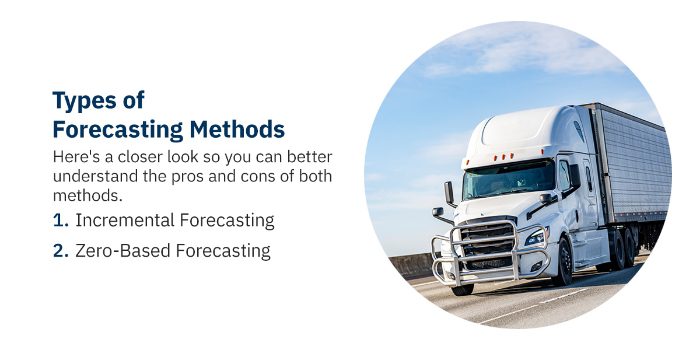
Types of Forecasting Methods
Fleet forecasting methods are the ways you can plan and adjust your budget for the year ahead. There are two main types of forecasting methods — incremental forecasting and zero-based forecasting. Here’s a closer look so you can better understand the pros and cons of both methods.
1. Incremental Forecasting
When using incremental forecasting to create your budget for the new fiscal year, you add a flat increase to the previous year’s budget. This opens up room in your budget should you experience any price increases or unexpected expenses.
For example, a fleet manager using incremental forecasting may apply a flat increase of 5% to last year’s spending to create the new year’s budget. If last year’s spending was $250,000, then the new budget with a flat increase of 5% would be $262,500.
The main benefit of incremental forecasting is that it’s a quick, easy way to prepare your budget for new expenses in the new year. While incremental forecasting can work for some fleets, it’s important to realize that it doesn’t consider whether the previous year’s spending was appropriate or necessary. It also doesn’t give you the insight or incentive you need to cut costs. Therefore, incremental forecasting can encourage increased, unnecessary spending, which can be especially damaging to small and mid-sized businesses.
2. Zero-Based Forecasting
In a zero-based forecasting situation, you justify every item in your fleet’s budget from zero instead of the amount spent from the previous year. Zero-based forecasting is a more rigorous process than incremental forecasting because you must itemize every expense your fleet faced in the previous year and any costs you could face in the coming fiscal year.
One of the primary negative aspects of zero-based forecasting is that it requires a great deal of effort and time to do the correct way. However, zero-based forecasting has many benefits for fleets of all sizes. You’ll develop a better cost-management culture at work, encouraging drivers, technicians and other employees to care about the money that goes into operating the fleet. You’ll also have more control over your budget, ensuring you can scale or cut back on spending as needed.
Factors to Consider
As you think about your fleet’s unique budgeting and forecasting needs, you must consider a few important cost factors that every fleet faces.
1. Depreciation Costs
Depreciation is a reduction in the value of a vehicle over time because of wear and tear. From the moment you drive your vehicle away from the dealership, it begins depreciating. Every day you use your fleet vehicles, they continue depreciating. This is why used vehicles, even ones that are only lightly used, are more affordable than brand-new assets.
Factors affecting depreciation include OEM rebates, the loan amortization term and invoicing. Depreciation also impacts your fleet resale price if you plan on remarketing in the coming year to open up space in your budget. While depreciation costs are inevitable, there are some actions you can take to save as much money as possible:
- Review your fleet vehicle selection process.
- Conduct life-cycle analyses.
- Engage in negotiations, especially when buying multiple vehicles.
- Reassign idle units.
- Use market trends to your advantage.
2. Fuel Costs
Your fleet vehicles require fuel to run unless you have a fully electric-powered fleet. Fuel prices are volatile depending on certain economic factors, so you should plan your budget according to the higher estimates regarding where fuel prices can go. When calculating fuel costs, remember to include the price per gallon, your vehicle’s fuel efficiency and total miles driven.
Seek to keep vehicle drivers on set routes and schedules to help you better determine how much you’ll be spending on fuel in a given period. You can also reduce fuel costs by investing in electric-powered vehicles. Many companies are starting to use regional transportation providers to reduce fuel costs.
3. Maintenance Costs
Maintenance costs are essential for any functioning fleet. Maintenance includes both reactive and preventive maintenance. Reactive maintenance occurs as needed whenever a vehicle breaks down, suffers damage or otherwise malfunctions. Preventive maintenance happens before malfunctions occur to extend the useful life cycle of fleet vehicles. Although preventive maintenance occurs regularly, it can help you save money by reducing the frequency of more serious, expensive fixes.
You can lower maintenance costs by keeping track of which fleet vehicles need replacement before they become a money pit. Follow all oil-life parameters, and always have drivers use in-network maintenance providers.
4. Other Cost Factors
As a fleet manager, you understand that fleet costs can come from many places and for many reasons. Your goal should be to reduce the amount of unexpected or unnecessary costs. Here are some other factors to know about:
- Tolls
- Violations
- Accident costs
- Delivery expenses
You can reduce the above cost factors by properly educating your drivers and partnering with the right third-party transportation providers who can consolidate these expenses and help you save money.
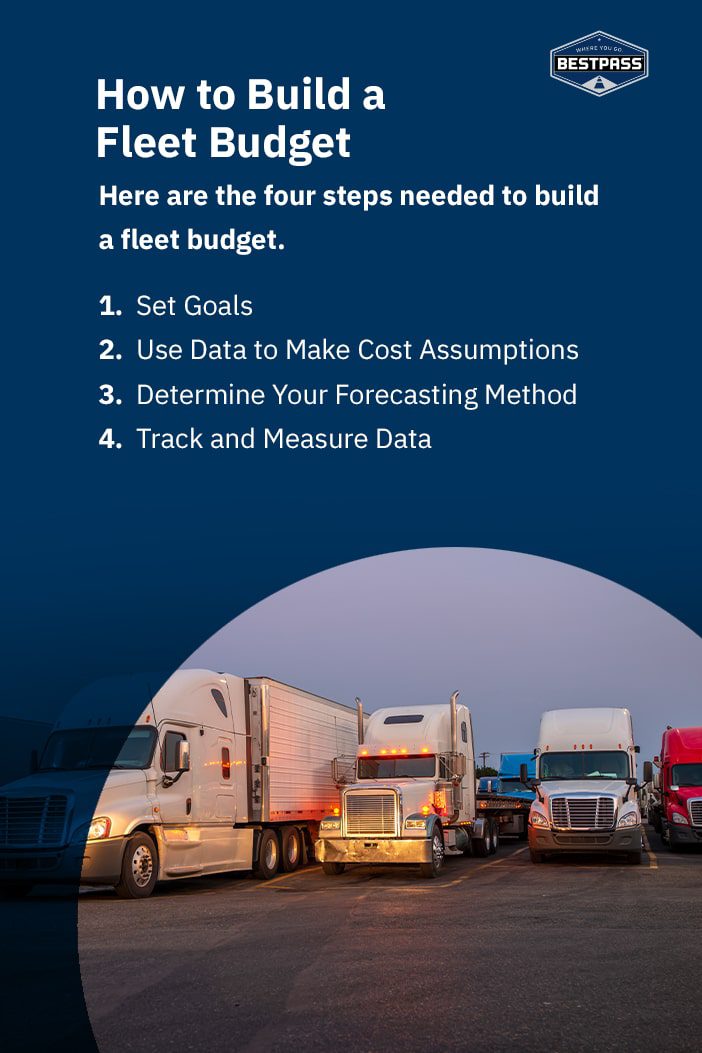
How to Build a Fleet Budget
With thoughtful attention to detail and a little patience, you can craft a powerful fleet budget that will help you know where your fleet currently stands and how you can improve it to reach your goals.
Here are the four steps needed to build a fleet budget.
1. Set Goals
Knowing how to make a fleet budget plan starts with goal setting. When you set goals, you will be more apt to stick to your budget, knowing that staying within your budget is one of the pillars of reaching your goals. Determine the specific objectives you want to achieve for your company and understand how your fleet budget can get you one step closer.
Some goals can be cutting spending on asset replacement or decreasing your fleet’s fuel costs. You’ll need to look at your fleet’s past expenses to understand where you’ve been and compare that to your current spending so you can monitor any improvement.
As you set goals, remember to analyze your fleet’s strengths, weaknesses and opportunities for improvement. Pinpoint any potential threats that can get in the way of reaching your goals. By taking this holistic approach to goal setting, you’ll find it’s much easier to stick to and craft a budget that benefits your business.
2. Use Data to Make Cost Assumptions
You make cost assumptions by looking back over your fleet’s previous spending. You can do this broadly in terms of annual spending, or you can get a bit more granular and look at your fleet’s previous quarterly spending over a year. By using past spending to determine which costs your fleet might face, you can better plan for future expenses and create an accurate budget that will meet the next year’s needs.
Make assumptions according to the two main types of costs — fixed costs and variable costs. Fixed costs don’t change regardless of how much you use your fleet. Here are some examples:
- Taxes
- Insurance
- Depreciation
- Licenses and permits
- Lease and loan payments
Variable costs do change depending on how much you use your fleet. Examples include the following:
- Fuel
- Tolls
- Parking
- Detailing
- Maintenance
- Parts replacement
Fixed and variable costs combine to inform you of your total cost of ownership.
3. Determine Your Forecasting Method
After you’ve set goals and made assumptions about your future spending, you must determine your forecasting method. Here, you’ll be choosing between incremental forecasting and zero-based forecasting. Every fleet is different, so choose the forecasting method that best suits your needs. You want your forecasting method to help you reach your goals, whether you add a fixed rate to last year’s spending or start from zero and budget all your expenses.
4. Track and Measure Data
You can get the most benefits from your budget when you use data to your advantage. Different types of software exist to help you make accurate predictions and budget determinations, including automated TCO calculation, optimal replacement analysis, fuel tracking and maintenance shop integration. With this data, you can make more confident budgeting decisions and measure your success throughout the fiscal year.
Choose Bestpass for Your Tolling Needs
As a fleet manager, you already have enough on your plate. Let Bestpass handle your fleet’s tolls to make your budgeting simpler than ever. It can be difficult to keep track of all the tolls your fleet gets. This cost can start to add up, especially if a driver accidentally misplaces a toll. We provide a comprehensive payment platform that makes paying tolls easy and, at times, more affordable than if you tried to do it all on your own.
Our services extend to service fleets, trucking fleets and owner-operators, so we can meet you right where you are. Contact us today to learn more about how we can help streamline your toll-payment process and free up space in your budget.
